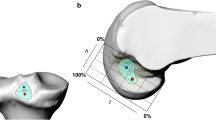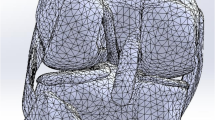Abstract
Purpose
The purpose of the study was to determine the change in the graft bending angles at the femoral and tibial tunnel aperture in single-bundle posterior cruciate ligament (PCL) reconstruction. It was hypothesized that different knee flexion and different tunnel directions may affect changes of the femoral and tibial graft bending angle.
Methods
The right knees of 12 male subjects were scanned with a high-resolution computed tomography scanner at 4 different knee flexion angles (0°, 45°, 90° and 135°). To begin with, the 3D knee models were created and manipulated with the use of several modeling programs.
Single-bundle PCL reconstruction was then virtually conducted in a 90° flexion model: The femoral and tibial graft bending angle, according to the various knee flexion angles, was calculated using a special software program.
Results
The femoral graft bending angle significantly decreased as the knee flexion increased between 0° and 135° (all p < 0.001). The femoral graft bending angle of the AL graft showed the most obtuse angles among the three types of the graft beyond 45° of knee flexion.
For the tibial graft bending angle, the anteromedial tunnel group showed significantly more acute tibial graft bending angle than the anterolateral tunnel group in all three types of the graft at all flexion angles (all p < 0.001).
Conclusion
Changes in the femoral graft bending angle were generally affected by different knee flexion angles. The effect of tibial tunnel direction on the tibial graft bending angle was found to be significant. The clinical relevance is that a mostly obtuse femoral graft bending angle was shown by the AL graft among three types of the graft.







Similar content being viewed by others
References
Anderson CJ, Ziegler CG, Wijdicks CA, Engebretsen L, LaPrade RF (2012) Arthroscopically pertinent anatomy of the anterolateral and posteromedial bundles of the posterior cruciate ligament. J Bone Joint Surg 94:1936–1945
Benedetto KP, Hoffelner T, Osti M (2014) The biomechanical characteristics of arthroscopic tibial inlay techniques for posterior cruciate ligament reconstruction: in vitro comparison of tibial graft tunnel placement. Int Orthop 38:2363–2368
Biswas D, Bible JE, Bohan M, Simpson AK, Whang PG, Grauer JN (2009) Radiation exposure from musculoskeletal computerized tomographic scans. J Bone Joint Surg 91:1882–1889
DeFrate LE, Gill TJ, Li G (2004) In vivo function of the posterior cruciate ligament during weightbearing knee flexion. Am J Sports Med 32:1923–1928
Hiraga Y, Ishibashi Y, Tsuda E, Toh HT (2006) Biomechanical comparison of posterior cruciate ligament reconstruction techniques using cyclic loading tests. Knee Surg Sports Traumatol Arthrosc 14:13–19
Huang TW, Wang CJ, Weng LH, Chan YS (2003) Reducing the “killer turn” in posterior cruciate ligament reconstruction. Arthroscopy 19:712–716
Jang KM, Park SC, Lee DH (2016) Graft bending angle at the intra-articular femoral tunnel aperture after single-bundle posterior cruciate ligament reconstruction: inside-out versus outside-in techniques. Am J Sports Med 44:1269–1275
Kim JG, Wang JH, Lim HC, Ahn JH (2012) Femoral graft bending angle and femoral tunnel geometry of transportal and outside-in techniques in anterior cruciate ligament reconstruction: an in vivo 3-dimensional computed tomography analysis. Arthroscopy 28:1682–1694
Kim SJ, Chang JH, Kang YH, Song DH, Park KY (2009) Clinical comparison of anteromedial versus anterolateral tibial tunnel direction for transtibial posterior cruciate ligament reconstruction: 2 to 8 years’ follow-up. Am J Sports Med 37:693–698
Kim SJ, Shin JW, Lee CH, Shin HJ, Kim SH, Jeong JH et al (2005) Biomechanical comparisons of three different tibial tunnel directions in posterior cruciate ligament reconstruction. Arthroscopy 21:286–293
LaPrade CM, Civitarese DM, Rasmussen MT, LaPrade RF (2015) Emerging updates on the posterior cruciate ligament: a review of the current literature. Am J Sports Med 43:3077–3092
Li Y, Zhang J, Song G, Li X, Feng H (2016) The mechanism of “killer turn” causing residual laxity after transtibial posterior cruciate ligament reconstruction. Asia Pac J Sports Med Arthrosc Rehabil Technol 3:13–18
Margheritini F, Mauro CS, Rihn JA, Stabile KJ, Woo SL, Harner CD (2004) Biomechanical comparison of tibial inlay versus transtibial techniques for posterior cruciate ligament reconstruction: analysis of knee kinematics and graft in situ forces. Am J Sports Med 32:587–593
Markolf KL, Feeley BT, Jackson SR, McAllister DR (2006) Where should the femoral tunnel of a posterior cruciate ligament reconstruction be placed to best restore anteroposterior laxity and ligament forces? Am J Sports Med 34:604–611
Markolf KL, McAllister DR, Young CR, McWilliams J, Oakes DA (2003) Biomechanical effects of medial-lateral tibial tunnel placement in posterior cruciate ligament reconstruction. J Orthop Res 21:177–182
Markolf KL, Zemanovic JR, McAllister DR (2002) Cyclic loading of posterior cruciate ligament replacements fixed with tibial tunnel and tibial inlay methods. J Bone Joint Surg 84:518–524
McAllister DR, Markolf KL, Oakes DA, Young CR, McWilliams J (2002) A biomechanical comparison of tibial inlay and tibial tunnel posterior cruciate ligament reconstruction techniques: graft pretension and knee laxity. Am J Sports Med 30:312–317
Mook WR, Civitarese D, Turnbull TL, Kennedy NI, O'Brien L, Schoeberl JB et al (2017) Double-bundle posterior cruciate ligament reconstruction: a biomechanical analysis of simulated early motion and partial and full weightbearing on common reconstruction grafts. Knee Surg Sports Traumatol Arthrosc 25:2536–2544
Narvy SJ, Hatch GF 3rd, Ihn HE, Heckmann ND, McGarry MH, Tibone JE et al (2017) Evaluating the femoral-side critical corner in posterior cruciate ligament reconstruction: the effect of outside-in versus inside-out creation of femoral tunnels on graft contact pressure in a synthetic knee model. Arthroscopy 33:1370–1374
Narvy SJ, Pearl M, Vrla M, Yi A, Hatch GF 3rd (2015) Anatomy of the femoral footprint of the posterior cruciate ligament: a systematic review. Arthroscopy 31:345–354
Ohkoshi Y, Nagasaki S, Yamamoto K, Urushibara M, Tada H, Shigenobu K et al (2001) A new endoscopic posterior cruciate ligament reconstruction: minimization of graft angulation. Arthroscopy 17:258–263
Papannagari R, DeFrate LE, Nha KW, Moses JM, Moussa M, Gill TJ et al (2007) Function of posterior cruciate ligament bundles during in vivo knee flexion. Am J Sports Med 35:1507–1512
Schoderbek RJ Jr, Golish SR, Rubino LJ, Oliviero JA, Hart JM, Miller MD (2009) The graft/femoral tunnel angles in posterior cruciate ligament reconstruction: a comparison of 3 techniques for femoral tunnel placement. J Knee Surg 22:106–110
Seo YJ, Song SY, Kim IS, Seo MJ, Kim YS, Yoo YS (2014) Graft tension of the posterior cruciate ligament using a finite element model. Knee Surg Sports Traumatol Arthrosc 22:2057–2063
Song Y, Debski RE, Musahl V, Thomas M, Woo SL (2004) A three-dimensional finite element model of the human anterior cruciate ligament: a computational analysis with experimental validation. J Biomech 37:383–390
Tompkins M, Keller TC, Milewski MD, Gaskin CM, Brockmeier SF, Hart JM et al (2013) Anatomic femoral tunnels in posterior cruciate ligament reconstruction: inside-out versus outside-in drilling. Am J Sports Med 41:43–50
Wang Z, Xiong Y, Chen G, Tang X, Li Q, Zhang Z et al (2019) Modified tibial tunnel placement for single-bundle posterior cruciate ligament reconstruction reduces the “Killer Turn” in a biomechanical model. Medicine (Baltimore) 98:e18439
Weimann A, Wolfert A, Zantop T, Eggers AK, Raschke M, Petersen W (2007) Reducing the “killer turn” in posterior cruciate ligament reconstruction by fixation level and smoothing the tibial aperture. Arthroscopy 23:1104–1111
Author information
Authors and Affiliations
Corresponding author
Ethics declarations
Conflict of interest
All named authors hereby declare that they have no conflicts of interest to disclose.
Funding
There is no funding statement for the current study.
Ethical approval
The institutional review board of hallym university, dongtan sacred heart hospital approved the study (IRB no. HDT2018-06–009).
Additional information
Publisher's Note
Springer Nature remains neutral with regard to jurisdictional claims in published maps and institutional affiliations.
Rights and permissions
About this article
Cite this article
Jung, M., Song, S.Y., Cha, M. et al. Graft bending angle of the reconstructed posterior cruciate ligament gradually decreases as knee flexion increases. Knee Surg Sports Traumatol Arthrosc 28, 2626–2633 (2020). https://doi.org/10.1007/s00167-020-05899-5
Received:
Accepted:
Published:
Issue Date:
DOI: https://doi.org/10.1007/s00167-020-05899-5




